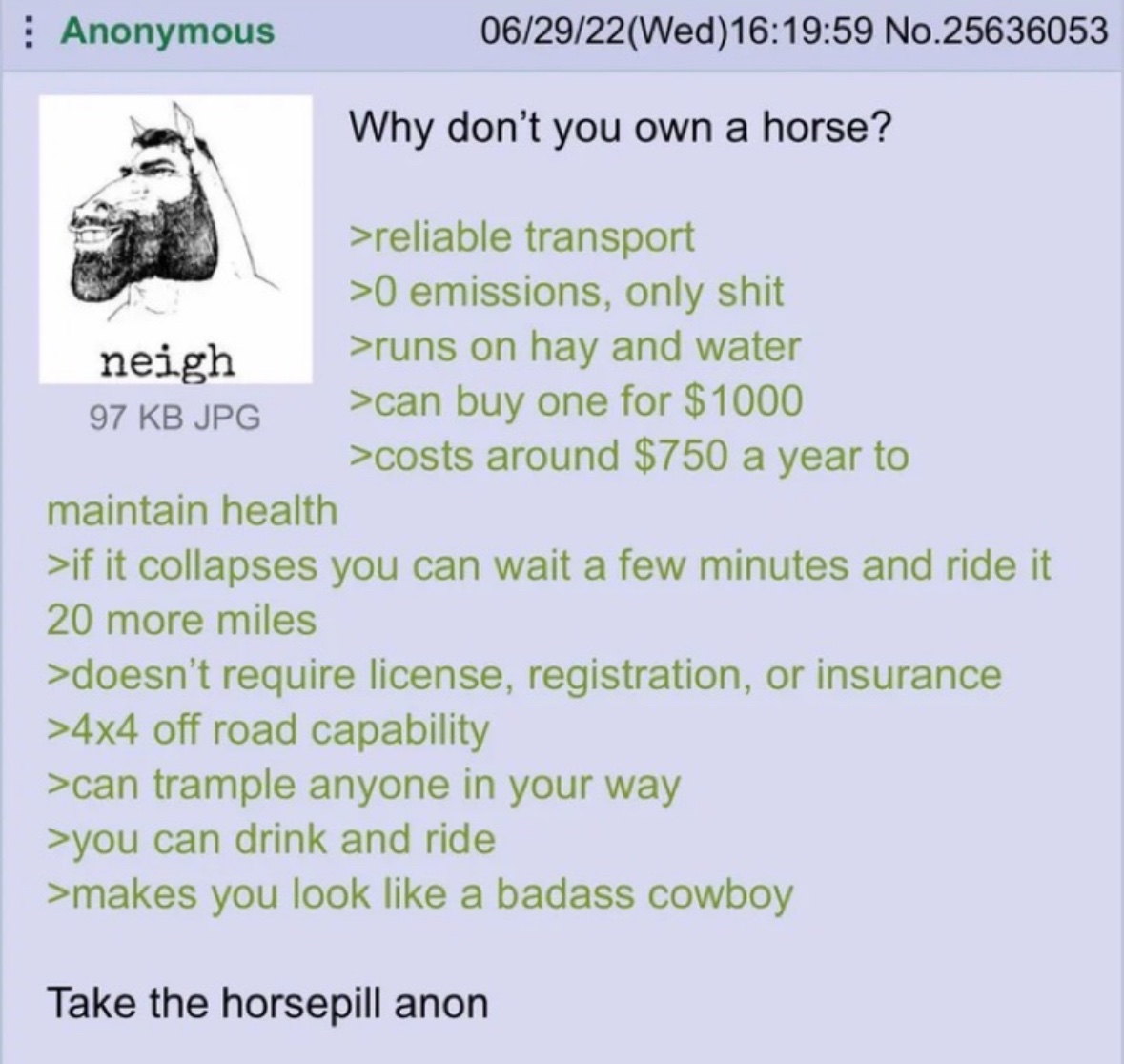this post was submitted on 11 Nov 2024
737 points (97.3% liked)
Greentext
7244 readers
1293 users here now
This is a place to share greentexts and witness the confounding life of Anon. If you're new to the Greentext community, think of it as a sort of zoo with Anon as the main attraction.
Be warned:
- Anon is often crazy.
- Anon is often depressed.
- Anon frequently shares thoughts that are immature, offensive, or incomprehensible.
If you find yourself getting angry (or god forbid, agreeing) with something Anon has said, you might be doing it wrong.
founded 2 years ago
MODERATORS
you are viewing a single comment's thread
view the rest of the comments
view the rest of the comments

All roads are gonna be blocked by defunct cars. If we're more than 5-10 years into the post-apocalypse, the roads are gonna be a series of craters. Still, a mountain bike will beat a horse in terms of utility. I wonder how the two compare in terms of repair-ability.
Bikes are pretty simple machines. Even if it rides like shit you can keep it rolling with duct tape, a hammer, and spit. Horses are brittle. Injuries that other animals walk off are a death sentence to them, and even with lesser injuries, it takes time to heal
Horses self-replicate, which bicycles can't do. Except maybe in the Netherlands, I think they do breed over there.
Not sure I want to watch that nature video...
How else to explain this?
There's a lot more roads than there are cars to fill them and the good thing about bikes is that if you can get past an obstacle on foot, you can carry your bike while doing so. Even if the major highways get blocked by the occasional massive pileup that you can't climb over while carrying your bike, you can always take the smaller road. And where would all the craters come from? How many artillery batteries and mortar companies do you expect to see in the post-apocalypse?
Surely they would have had their fill at the start of the apocalypse, no?
Eh, depends on if we go out with a bang or a whimper. I'm betting it's going to be the latter.
If not, then it's likely that nukes put a stop to the artilleryfest before it has a chance to really get going. And my point about there being a lot of roads in the world still stands. No military would start to target roads in any meaningful scale when they're going to save their precious shells for the enemy.
Right, but where are the enemy likely to be? Along major roads and highways. Armies need to move their military equipment somehow, so that's where you're likely to see the bombs being used the most. That, and in cities to control the movements of your enemy. I doubt we'd jump straight to nukes, it's more likely going to be a slog fest with traditional weapons until one of the sides gets desperate (e.g. Russia v Ukraine).
Sure, but the roads the enemy is using are a vast minority of all the roads out there, constrained to certain geographical areas. If one happens to be in the middle of it, they'll have bigger concerns than whether to invest in a bike or a horse.
If it's the apocalypse, then everyone will be desperate.
So long as you have at least two, horses conveniently produce additional horses which makes repair-ability less of an issue. You simply eat the broken horse, if possible.
Honestly, as long as you have enough horses, you don't need to wait for them to break in order to eat them, use them for a few years and upgrade to a newer model.